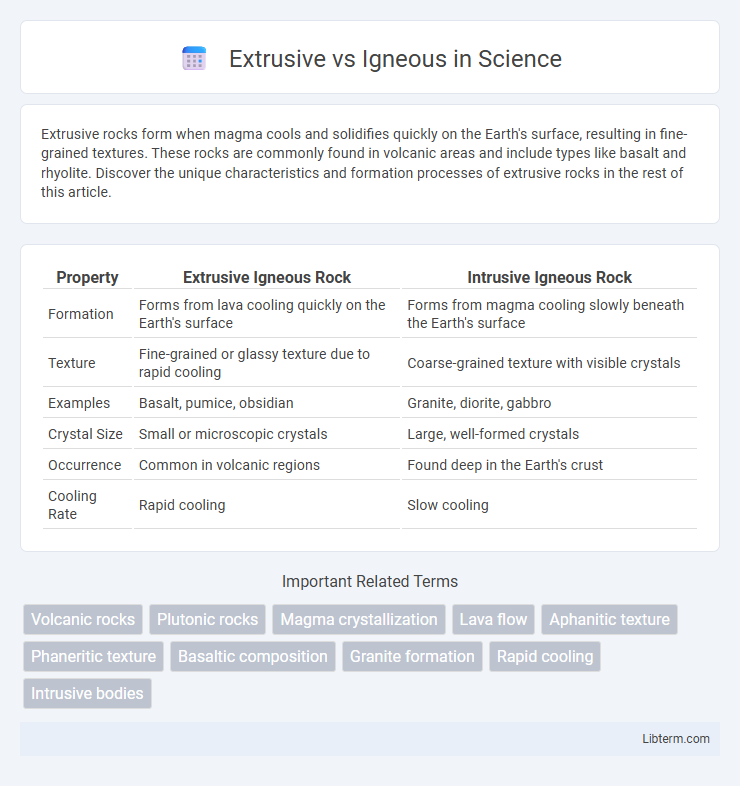Extrusive rocks form when magma cools and solidifies quickly on the Earth's surface, resulting in fine-grained textures. These rocks are commonly found in volcanic areas and include types like basalt and rhyolite. Discover the unique characteristics and formation processes of extrusive rocks in the rest of this article.
Table of Comparison
| Property | Extrusive Igneous Rock | Intrusive Igneous Rock |
|---|---|---|
| Formation | Forms from lava cooling quickly on the Earth's surface | Forms from magma cooling slowly beneath the Earth's surface |
| Texture | Fine-grained or glassy texture due to rapid cooling | Coarse-grained texture with visible crystals |
| Examples | Basalt, pumice, obsidian | Granite, diorite, gabbro |
| Crystal Size | Small or microscopic crystals | Large, well-formed crystals |
| Occurrence | Common in volcanic regions | Found deep in the Earth's crust |
| Cooling Rate | Rapid cooling | Slow cooling |
Introduction to Igneous Rocks
Igneous rocks form through the cooling and solidification of magma or lava, classified into intrusive (plutonic) and extrusive (volcanic) types based on their cooling environment. Extrusive igneous rocks crystallize rapidly on the Earth's surface, resulting in fine-grained textures, while intrusive igneous rocks cool slowly beneath the surface, producing coarse-grained textures. Common examples of extrusive rocks include basalt and pumice, whereas granite and diorite are typical intrusive rocks.
What Are Extrusive Igneous Rocks?
Extrusive igneous rocks form when magma erupts onto the Earth's surface and cools rapidly, resulting in fine-grained or glassy textures. Common examples include basalt, pumice, and obsidian, characterized by their small crystals due to quick solidification. These rocks differ from intrusive igneous rocks, which cool slowly beneath the surface, producing larger crystals.
Formation Processes of Igneous Rocks
Igneous rocks form through the cooling and solidification of molten magma or lava, with extrusive igneous rocks crystallizing on the Earth's surface from lava that cools rapidly. Intrusive igneous rocks form beneath the surface when magma cools slowly, allowing larger crystals to develop. The cooling rate directly influences the texture and mineral composition of intrusive versus extrusive igneous rocks.
Key Differences: Extrusive vs. Intrusive Igneous Rocks
Extrusive igneous rocks form from lava cooling quickly on the Earth's surface, resulting in fine-grained textures, while intrusive igneous rocks crystallize slowly beneath the surface, producing coarse-grained minerals. Key differences include cooling rates, grain size, and formation environment, with extrusive rocks exhibiting rapid solidification and smaller crystals compared to the larger, well-formed crystals in intrusive rocks. Examples of extrusive rocks are basalt and rhyolite, whereas granite and diorite represent common intrusive varieties.
Common Types of Extrusive Igneous Rocks
Common types of extrusive igneous rocks include basalt, andesite, rhyolite, and obsidian, each formed from rapid cooling of lava on the Earth's surface. Basalt is the most abundant extrusive rock, characterized by fine-grained texture and mafic composition. Rhyolite has a high silica content and often exhibits a glassy or porphyritic texture, while obsidian is volcanic glass formed by extremely rapid cooling.
Texture and Appearance Differences
Extrusive igneous rocks form from lava that cools rapidly on the Earth's surface, resulting in fine-grained or glassy textures with small or no visible crystals, such as basalt or obsidian. In contrast, intrusive igneous rocks cool slowly beneath the surface, allowing large, coarse-grained crystals to develop, exemplified by granite and diorite. This difference in cooling rate creates distinct appearances, where extrusive rocks appear smoother and more uniform, while intrusive rocks have a visibly granular texture.
Cooling Rates and Crystal Size
Extrusive igneous rocks form when magma cools rapidly on the Earth's surface, resulting in fine-grained or glassy textures with small or no visible crystals. Intrusive igneous rocks, in contrast, cool slowly beneath the surface, allowing large crystals to develop due to the extended cooling period. The cooling rate directly influences crystal size, with faster cooling producing smaller crystals and slower cooling yielding larger, well-formed crystals.
Geological Significance of Extrusive Rocks
Extrusive rocks, a subset of igneous rocks, form from the rapid cooling of magma on the Earth's surface, leading to fine-grained textures critical for interpreting volcanic activity and lava flow histories. Their composition and structure provide essential data on the Earth's crust evolution and past tectonic settings. These rocks play a vital role in understanding geohazards and the mineral wealth associated with volcanic regions.
Uses and Applications of Igneous Rocks
Igneous rocks, including extrusive types like basalt and rhyolite, are widely used in construction due to their durability and strength, making them ideal for building foundations, road pavements, and aggregate materials. Their heat-resistant properties also make them suitable for manufacturing countertops, tiles, and monuments. Furthermore, igneous rocks play a critical role in landscaping and decorative stone applications, enhancing aesthetic appeal while providing structural stability.
Summary: Choosing Between Extrusive and Intrusive Rocks
Extrusive rocks form from lava cooling quickly on the Earth's surface, resulting in fine-grained textures, while intrusive igneous rocks crystallize slowly underground, producing coarse-grained structures. Choosing between extrusive and intrusive rocks depends on desired mineral size, texture, and cooling history relevant to geological applications or construction needs. Petrologists analyze these differences to determine rock origins and their suitability for engineering or environmental projects.
Extrusive Infographic

 libterm.com
libterm.com